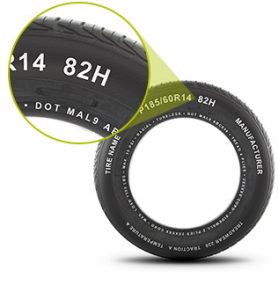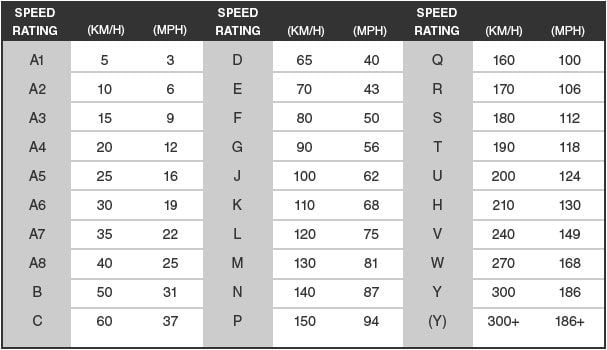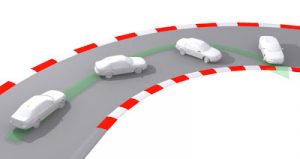
A speed rating is a letter or a combination of a letter and a number which implies to what extent the tire successfully dissipates heat. Exceeding that speed will make the tire performance differ from the initial specifications. This may lead to anything from temporary traction loss to rapid deflation and irreparable damage.
The rating doesn’t mean you can safely drive at the maximum speed for a long time however, especially in extreme weather conditions. You can only maintain that speed for about 10 minutes before the tire overheats and its performance deteriorates.
Where to Search for a Speed Rating?
You can find the rating in/on the:
- Owner’s manual.
- Tire sidewall.
- Driver’s side door jamb.
- Glove box door.
- Gas tank hatch.
The owner’s manual has all the information you need about the recommended tires for your vehicle. Information placards on the door jamb, glove box door, and gas tank hatch are for the cases when you need a quick recommendation while on the go. As for the tire codes, there you will see a speed rating for the particular tire. There will be no vehicle-related recommendations, so it would be wise to consult both the vehicle manufacturer’s suggestions and the markings on the tires.
How Speed Rating Works
How Does a Tire Get a Rating?
Tires get the ratings according to the results of the tests where speeds and loads are simulated. In brief, a specialist inflates a tire to the recommended pressure and puts it into a large drum. It then rotates the tested tire, increasing speeds by 6.2 mph every 10 minutes. As the rotation reaches the estimated maximum speed for the tire, the specialist checks whether the tire keeps its integrity.
The conditions for the tests are perfect, so special road/environment-related conditions aren’t included. That’s why the actual maximum speed of the tire is often lower than its speed rating. If the tire is even slightly underinflated, or the vehicle is overloaded, or it’s boiling hot outside, the ratings may become irrelevant.
What Does the Speed Rating Influence?
Aside from speed, this rating influences:
- Heat build-up.
Tires with lower ratings flex harder under pressure, which causes heat build-up. It may cause a wide range of issues, from premature aging to tire failure and immediate blowouts. Tires with higher ratings have special compounds and reinforcements that help avoid excess heat build-up. - Braking.
Low-rated tires will stop for a longer amount of time, as they change shape and squirm during hard braking. Take two tires with the speed ratings S and V and ride them at 100 km/h. As the V tire comes to a full stop, the S tire still goes at about 25 km/h. The difference in braking distance turns out to be about 4 m (about 13 ft) in this case, but when talking about emergency braking, this difference will play a big role. - Cornering grip.
Just as a low-rated tire will deform when braking, it will when cornering. The contact patch area also changes its shape during hard turns, making the grip worse. Heat-up may follow and add to the condition. - Steering responsiveness.
Less flex and the overall construction of the tires with a higher speed rating will make your vehicle more responsive. So, you won’t have to turn the steering wheel more and wait for the reaction of your tires. Lower ratings also perform well and are responsive, but only at the speeds they are designed for.
Speed ratings are often called performance ratings, as they influence most aspects of traction and responsiveness. For better speed handling, the construction of the tire has to be improved. That’s why high-rated tires are considered higher in quality. Low-rated tires are still useful for vehicles with capacities matching those tires. That’s why it isn’t recommended to buy a sports low-profile tire with a Y rating if you need a regular H-rated tire.
How to Read A Speed Rating
Nowadays, the system uses the letters A to Z and numbers 1 to 3 for the “A”. Each letter or letter and number combo represent a certain speed, as shown in the table. As the alphabet goes forward, the speeds become higher, mostly. You can guide yourself using a table or just remember the letter specified in your owner’s manual.

Here are some of the irregularities to know about when reading speed ratings:
- The “H” rating is between the “U” and the “V”, not after the “G”. The speed of the rating corresponds to its position.
- There are no “I”, “O”, and “X” ratings. There are also charts that exclude the “P” rating.
- The lowest ratings are “A1”, “A2, and “A3”.
- For the “W” and “Y” ratings, some manufacturers include “Z” into the tire side code after the aspect ratio.
NOTE: The maximum speeds seem unusual in mph. This is because the system of speed rating was developed in Europe, where speed is in km/h.
Tire Type and Speed Rating
The ranges are the following:
- All-season tires are usually of the “S” and “T” ratings.
- Performance all-season tires are of the “H” and “V” ratings.
- Ultra-high performance tires are can be of the “ZR”, “W”, and “Y” ratings.
- All-season truck tires are of the “S”, “T”, and “H” ratings.
- All-season SUV (sport utility vehicles) tires are of the “T” and “H” ratings.
- All-terrain off-road tires can be of the “L” to “S” ratings.
- Winter/snow tires are of the “Q” rating and higher.
- Performance winter tires are of the “H” rating and higher.
- Truck winter tires are usually of the “S” rating.
- Temporary spare tires are usually of the “M” rating.
Vehicle Type and Tire Speed Rating
Here are the correlations between the ratings and types of vehicles:
- Family vans and sedans will go well with S- or T-rated tires.
- Sedans and coupes will get enough speed from U-rated tires.
- Sport sedans and coupes can start with H- or V-rated tires.
- Exotic sports cars will work great with the high-speed capable W-, Y-, and (Y)-rated tires.
- Heavy-duty light trucks will go with R-rated tires.
Before choosing a tire according to such examples, consult your owner’s manual for suggestions from the manufacturer.
FAQ on Speed Ratings: Everything You Need to Know
What Speed Rating Should I Choose?
The most appropriate variant is within the owner’s manual or using the same size, load, speed, etc. as your original set. However, you can go a bit higher if you have extreme weather conditions in your area, or if the roads are bad, etc. Downgrading tires is strongly not recommended, as the maximum speed and performance will degrade, endangering you and the vehicle.
Can I Mix Tires with Different Speed Ratings?
It isn’t recommended, however, if you have to use different tires for some time, mount them in pairs on the axles. The pairs must be of the same rating, and it’s the best if the lower-rated pair is on the front axle. This will help avoid oversteer. Remember that in this case, your vehicle will be limited according to the rating of the lower-rated tires.

What Speed Ratings Are the Best for My Off-Road Vehicle?
For regular off-road vehicles, speed isn’t the first priority – traction is. Usually, L-rated tires are recommended, but it may be higher depending on the model of the vehicle. Off-road tires are reinforced no matter the rating. So, unless you have a sports truck and need more speed, stick to the manufacturer’s recommendations.
Are Higher Speed Indexes Better?
Within the most appropriate range for your type of vehicle – yes. However, it depends on your needs. If you often drive loaded at highway speeds and it’s hot in your area, you may want to consider a higher rating. But if you drive in a city mostly, where there are speed restrictions, you may want to stay closer to the bottom of the suitable indexes. Tires with higher speed capabilities usually cost more, so if you don’t need them, there’s no sense in spending more.
Is the Speed Rating Important for Winter Tires?
Yes, it’s important for any tires, but winter ones are an exception from the “no downgrade” rule. You can install tires with a slightly lower rating than your original tires. This is because in winter, people usually drive at slower speeds, so these capabilities become less relevant. The “Q” rating is the most regular and frequently used in snow tires.
